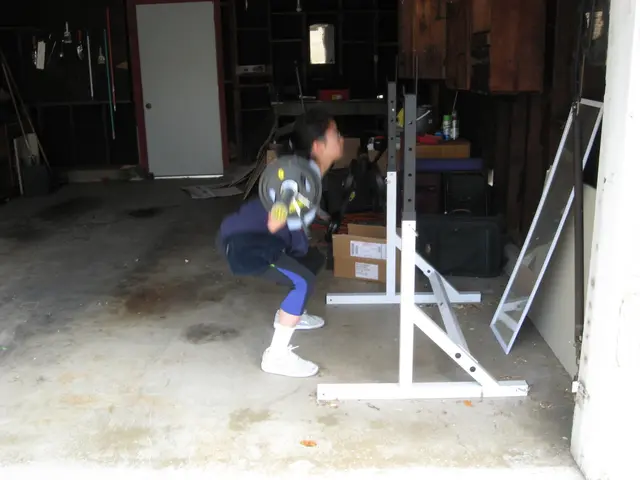Quick and portable fitness routines for optimal workouts anytime, anywhere:
Building and Maintaining Strength: The Advantage of Bodyweight Exercises
Strength training is crucial for muscle development, heart health, and injury prevention. However, the thought of paying for a costly gym membership to share space with a crowd of sweaty patrons may deter some individuals.
Luckily, Dr. Lyndsey Booker, a physical medicine and rehabilitation doctor and sports medicine specialist with UW Medicine, explains that it is not necessary to join a bustling gym to participate in strength training. Enter bodyweight exercises, a versatile solution that can be performed anywhere and tailored to various fitness levels or health concerns.
"Bodyweight exercises leverage your body's mass as resistance for strength training benefits," says Booker. The range of bodyweight exercises extends from basic movements like push-ups and squats to more intricate exercises such as planks and lunges.
One of the significant advantages of bodyweight exercises is their portability. "Because they can be done practically anywhere, these exercises are ideal for individuals who frequently travel or lack access to a gym," Booker notes. Small spaces, open walls, benches, beds, and stairs can all transform into makeshift training areas.
For those new to bodyweight exercises, Booker advises starting slowly and gradually increasing the intensity and frequency of workouts. For instance, squats are excellent for beginning bodyweight exercises, but a full squat may be challenging for some. In such cases, begin with quarter squats against a wall. As this becomes easier, progress to half squats, and eventually attempt full squats.
"It is essential to establish tolerance for the movements, even if you cannot perform the full range of motion initially," says Booker. She also emphasizes that consistency and commitment are among the primary obstacles in physical activity. Aim to incorporate bodyweight exercises into your routine two to three times a week, starting with shorter, five-to-ten-minute sessions, and gradually increasing the length and intensity of your workouts.
If you experience soreness after bodyweight exercises, it does not necessarily indicate that you should halt your strength training program. "A little soreness is to be expected, especially if you haven't been regularly utilizing those muscles," Booker explains. If the soreness subsides within two to three days, it is typically safe to resume workouts. However, if discomfort persists or worsens, take a break or modify your routine.
For those seeking to enhance their bodyweight exercises on a budget, Booker recommends small dumbbells (1-2 pounds) for added resistance to upper body exercises and resistance bands to increase the intensity of bodyweight exercises.
The American College of Sports Medicine suggests that adults perform strength training exercises at least two days per week. Booker encourages alternating strength training days, especially for those starting a new exercise routine. To target all major muscle groups, she recommends performing 8 to 10 different exercises.
Upper Body Exercises
- Push-ups: A widely recognized exercise that targets the chest, shoulders, and triceps. Begin in a high plank position, lower your body until your arms form a 90-degree angle, then push back up. For easier variations, perform the exercise on your knees or push off a wall at an angle. Begin with three sets of ten repetitions.
- Tricep dips: Sit on the ground or use a chair or set of steps with your knees straight and palms flat on the ground next to your hips. Raise your hips, lower your body toward the ground by bending your elbows, then raise yourself back up. For modified tricep dips, bend your knees. Complete three sets of ten repetitions.
Lower Body Exercises
- Wall sits: With your back against the wall, slide down until you are in a seated position, with your thighs parallel to the floor. Start with three sets of thirty seconds each.
- Forward and reverse lunges: Stand with feet shoulder-width apart, place your hands on your hips, and step one foot forward. Bend both knees until each is at a 90-degree angle. Repeat in reverse, stepping one foot backward. Complete three sets of ten repetitions per leg.
Core Exercises
- Planks: Position your body in a raised, push-up position, with toes and palms touching the floor, face down, and core tight. Hold this pose for thirty seconds. To modify, place your knees on the ground or rest on your forearms rather than your palms. Complete three sets of thirty seconds each.
- Bicycle crunches: Lie flat on your back, raise your knees to a 90-degree angle, and twist your body to bring one elbow and the opposite knee together. Then, bring the opposite elbow and the same knee together. Complete three sets of twelve repetitions per side.
Full Body Exercises
- Mountain climbers: From a plank position, bring your right knee toward your left elbow. Return to plank, then repeat with your left knee toward your right elbow.
- Burpees: Begin in a standing position, move into a squat, kick your legs back into a plank position, do a full push-up, return to a squat, and jump up. Complete three sets of thirty seconds.
Bodyweight exercises, such as push-ups and squats, can be performed anywhere, making them a portable strength training solution for individuals who travel or lack access to a gym. For those new to bodyweight exercises, starting with basic moves like wall sits and gradually progressing to exercises like burpees can help build strength and fitness over time.






